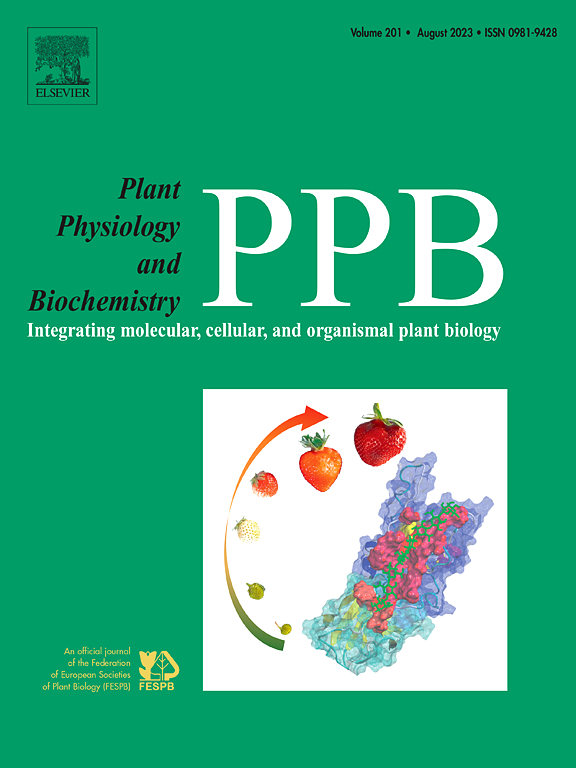Regiospecific hydroxylase and O-methyltransferase for the biosynthesis of anticancer alkaloids in Tabernaemontana elegans (toad tree)
IF 6.1
2区 生物学
Q1 PLANT SCIENCES
引用次数: 0
Abstract
Monoterpenoid indole alkaloids (MIAs) are a structurally diverse class natural products with significant medicinal properties. Bis-MIAs, such as chemotherapeutic vinblastine and anti-autophagic conodurine, are synthesized through enzymatic coupling of monomeric MIAs, often requiring specific modifications to activate reactive centers. In this study, we report the identification and characterization of a regiospecific enzyme pair, coronaridine 11-hydroxylase (TeC11H) and 11-hydroxycoronaridine O-methyltransferase (TeHCOMT), from Tabernaemontana elegans (toad tree). The C11-methoxylation of coronaridine activates C10 and C12 on the indole for subsequent coupling with a vobasinyl monomer, representing a critical transformation in the biosynthesis of a series of 11-methoxycoronaridine derived bis-iboga-vobasinyl MIAs in T. elegans root with potent anticancer and anti-autophagy activities. Biochemical analysis and homology modeling of TeC11H and TeHCOMT, along with their Tabernanthe iboga (iboga) homologs for coronaridine C10-methoxylation, reveal key residues at their highly similar active sites responsible for distinct regioselectivity, demonstrating how coronaridine is oriented to favour C11 or C10 methoxylation. Our discovery sheds light on the coordinated specification of active sites in metabolically linked enzymes during evolutionary adaptation in different lineages. TeC11H and TeHCOMT represent a valuable tool for metabolic engineering, offering new opportunities to biosynthesize anticancer alkaloids and explore the therapeutic potential of novel bis-MIAs.

蟾蜍树抗肿瘤生物碱合成的区域特异性羟化酶和o -甲基转移酶
单萜类吲哚生物碱是一类结构多样的天然产物,具有重要的药用价值。双失联蛋白,如化疗长春碱和抗自噬concondurine,是通过酶偶联单体失联蛋白合成的,通常需要特异性修饰来激活反应中心。在这项研究中,我们报道了一个区域特异性酶对,冠状核糖啶11-羟化酶(TeC11H)和11-羟基冠状核糖啶o -甲基转移酶(TeHCOMT),从塔贝纳蒙塔纳elegans(蟾蜍树)。冠状核糖啶的c11 -甲氧基化激活了吲哚上的C10和C12,随后与一个沃巴辛基单体偶联,这是线虫根中一系列11-甲氧基冠状核糖啶衍生的双iboga-沃巴辛基MIAs生物合成的关键转变,具有强大的抗癌和抗自噬活性。TeC11H和TeHCOMT的生化分析和同源性建模,以及它们的Tabernanthe iboga (iboga)同源物对冠状苯胺C10-甲氧基化的影响,揭示了它们高度相似的活性位点上的关键残基对不同的区域选择性负责,证明了冠状苯胺是如何倾向于C11或C10甲氧基化的。我们的发现揭示了不同谱系在进化适应过程中代谢相关酶活性位点的协调规范。TeC11H和TeHCOMT为代谢工程提供了有价值的工具,为生物合成抗癌生物碱和探索新型双酶抑制剂的治疗潜力提供了新的机会。
本文章由计算机程序翻译,如有差异,请以英文原文为准。
求助全文
约1分钟内获得全文
求助全文
来源期刊
CiteScore
11.10
自引率
3.10%
发文量
410
审稿时长
33 days
期刊介绍:
Plant Physiology and Biochemistry publishes original theoretical, experimental and technical contributions in the various fields of plant physiology (biochemistry, physiology, structure, genetics, plant-microbe interactions, etc.) at diverse levels of integration (molecular, subcellular, cellular, organ, whole plant, environmental). Opinions expressed in the journal are the sole responsibility of the authors and publication does not imply the editors'' agreement.
Manuscripts describing molecular-genetic and/or gene expression data that are not integrated with biochemical analysis and/or actual measurements of plant physiological processes are not suitable for PPB. Also "Omics" studies (transcriptomics, proteomics, metabolomics, etc.) reporting descriptive analysis without an element of functional validation assays, will not be considered. Similarly, applied agronomic or phytochemical studies that generate no new, fundamental insights in plant physiological and/or biochemical processes are not suitable for publication in PPB.
Plant Physiology and Biochemistry publishes several types of articles: Reviews, Papers and Short Papers. Articles for Reviews are either invited by the editor or proposed by the authors for the editor''s prior agreement. Reviews should not exceed 40 typewritten pages and Short Papers no more than approximately 8 typewritten pages. The fundamental character of Plant Physiology and Biochemistry remains that of a journal for original results.

 求助内容:
求助内容: 应助结果提醒方式:
应助结果提醒方式:


